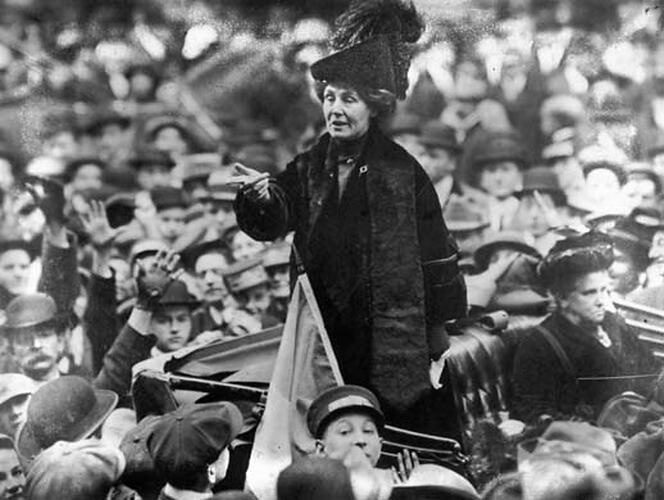Emmeline Pankhurst came from a liberal upbringing. She realised early in her life that men regarded women as a servant class within the community, and that women needed to be proactive in lifting themselves out of this situation.[1] In 1897 various suffrage groups formed under the umbrella association the National Union of Women's Suffrage Societies, led by Millicent Fawcett.[2] Early female suffragists peacefully lobbied the bureaucracy.[3] However, the Pankhursts' believed that insufficient progress was being made.[4]
With support from her daughters Christabel, Sylvia and Adela, Emmeline Pankhurst established the Women's Social and Political Union (WSPU) on 10 October 1903 at a gathering at the Pankhursts' home in Manchester.[5] The term suffragette was coined by a Daily Mail journalist, Charles E. Hands, and was quickly adopted by the WSPU to distinguish its members from suffragists they termed 'non' or 'anti' militant.[6]
The term may have originally been intended to mock or demean, but it was re-interpreted by the WSPU to stand for a new type of femininity that emphasised strength, courage, ardour and wit; to challenge traditional stereotypes of what 'womanly' meant.[7] The WSPU was strictly independent of class, as well as entirely female in its membership.[8] Emmeline Pankhurst called it 'a suffrage army in the field'.[9] The WSPU pushed suffrage as a social and political issue and galvanised the public and private spheres in the name of the cause. The phrase 'Votes for Women' was the official watchword of the Union.[10] Protests were designed to be noticeable and newsworthy to the public. They heckled politicians and held public rallies, before later instigating more violent tactics including smashing windows and cutting telephone wires, though methods were always aimed at property and not people.[11]
References
[1] Emmeline Pankhurst, My Own Story, (New York: Kraus Reprint Co. 1971), 35.
[2] Bradley, 'Women's Suffrage Souvenirs', 79.
[3] Martin Pugh, The March of the Women: A Revisionist Analysis of the Campaign for Women's Suffrage 1866-1914 (Oxford: Oxford University Press, 2000), 63.
[4] Angela K. Smith, Suffrage Discourse in Britain During the First World War (Aldershot: Ashgate Publishing, 2005), 21.
[5] Crawford, The Women's Suffrage Movement: A Reference Guide 1866-1928, 726.
[6] Sandra Stanley Holton, "Manliness and Militancy: The Political Protest of Male Suffragists and the Gendering of the 'Suffragette' Identity," in The Men's Share? Masculinities, Male Support and Women's Suffrage in Britain 1890-1920, eds. Angela V. John and Claire Eustance, (London: Routledge, 1997), 129.
[7] Holton, 'Manliness and Militancy', 112.
[8] E. Sylvia Pankhurst, The Suffragette: The History of the Women's Militant Suffrage Movement 1905-1910 (New York; Source Book Press, 1970), 7.
[9] Pankhurst, My Own Story, 59.
[10] Pankhurst, The Suffragette, 7.
[11] Diana Souhami, A Woman's Place: The Changing Picture of Women in Britain, (Harmondsworth: Middlesex, 1986), 24.
More Information
-
Keywords
-
Authors
-
Article types

